Class and Object
2016-06-10 10:09
519 查看
一个类可以定义自己类型的对象吗?
定义静态类没有问题,因为他们是共享的
这个是没问题的啊,可以想到做的leetcode里面怎么定义treeNode的。这里面不知道是不是有一个默认构造函数,base1指向null的。()
能够编译成功,但运行出错
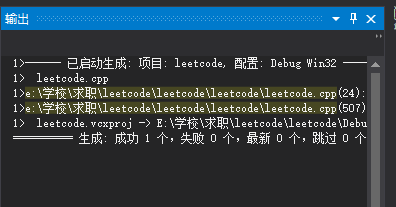

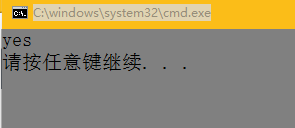
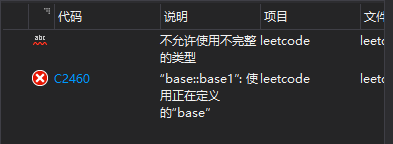
解释:类里面再定义一个本类,然后本类再定义另外一个类,无穷无尽啊。
为什么空类大小不为0
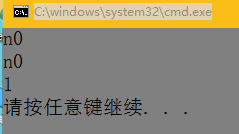
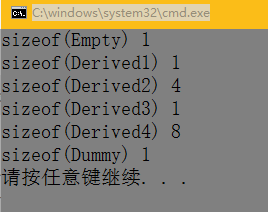
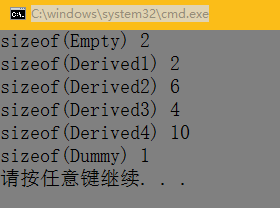
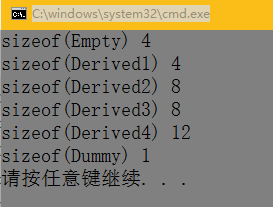
总结,继承一个空类,不会在原有大小为1 的基础上增加对应的大小。
如果有虚函数,那就先加4,因为里面有虚指针。
第一个里面,一开始为空,到了虚函数,先加4,然后char c本身占据1个字节,但是不能小于之前的字节量,所以也加4;
第二个里面,short int 占据2个字节,在public那边,已经占据2个,char c本身占据1个字节,但再加的内存不能再小于2,所以加2,得4;到了虚函数,先加4,然后char c本身占据1个字节,但是不能小于之前的字节量,所以也加4,得10;
最后一个同理了,int首先是4字节,后面增加的不能小于4,所以出现一个12
类中定义静态变量
class base {
static base base1;
};
int main() {
return 0;
}定义静态类没有问题,因为他们是共享的
类中定义指针
class base {
base *base1;
};
int main() {
return 0;
}这个是没问题的啊,可以想到做的leetcode里面怎么定义treeNode的。这里面不知道是不是有一个默认构造函数,base1指向null的。()
int main() {
class base {
public:
base *base1;
};
base w;
if (w.base1 == NULL)
cout << "yes" << endl;
return 0;
}能够编译成功,但运行出错


int main() {
class base {
public:
base *base1;
base():base1(NULL){}
};
base w;
if (w.base1 == NULL)
cout << "yes" << endl;
return 0;
}
类中再定义类
class base {
base base1;
};
int main() {
return 0;
}
解释:类里面再定义一个本类,然后本类再定义另外一个类,无穷无尽啊。
为什么空类大小不为0
#
空类不为0,是为了生成不同类的时候,他们所在地址不相同。class base {
};
int main() {
base *a =new base(), *b = new base();
if (a == b)
cout << "yes" << endl;
else
cout << "n0" << endl;
base c, d;
if (&c==&d)
cout << "yes" << endl;
else
cout << "n0" << endl;
return 0;
}
题目1
class Empty{ };
class Derived1 : public Empty{};
class Derived2 : virtual public Empty{};
class Derived3 : public Empty{
char c;
};
class Derived4 : virtual public Empty{
char c;
};
class Dummy{
char c;
};
int main() {
cout << "sizeof(Empty) " << sizeof(Empty) << endl;
cout << "sizeof(Derived1) " << sizeof(Derived1) << endl;
cout << "sizeof(Derived2) " << sizeof(Derived2) << endl;
cout << "sizeof(Derived3) " << sizeof(Derived3) << endl;
cout << "sizeof(Derived4) " << sizeof(Derived4) << endl;
cout << "sizeof(Dummy) " << sizeof(Dummy) << endl;
return 0;
}
#
class Empty{ short int i; };
class Derived1 : public Empty{};
class Derived2 : virtual public Empty{};
class Derived3 : public Empty{
char c;
};
class Derived4 : virtual public Empty{
char c;
};
class Dummy{
char c;
};
int main() {
cout << "sizeof(Empty) " << sizeof(Empty) << endl;
cout << "sizeof(Derived1) " << sizeof(Derived1) << endl;
cout << "sizeof(Derived2) " << sizeof(Derived2) << endl;
cout << "sizeof(Derived3) " << sizeof(Derived3) << endl;
cout << "sizeof(Derived4) " << sizeof(Derived4) << endl;
cout << "sizeof(Dummy) " << sizeof(Dummy) << endl;
return 0;
}
#
class Empty{ int i; };
class Derived1 : public Empty{};
class Derived2 : virtual public Empty{};
class Derived3 : public Empty{
char c;
};
class Derived4 : virtual public Empty{
char c;
};
class Dummy{
char c;
};
int main() {
cout << "sizeof(Empty) " << sizeof(Empty) << endl;
cout << "sizeof(Derived1) " << sizeof(Derived1) << endl;
cout << "sizeof(Derived2) " << sizeof(Derived2) << endl;
cout << "sizeof(Derived3) " << sizeof(Derived3) << endl;
cout << "sizeof(Derived4) " << sizeof(Derived4) << endl;
cout << "sizeof(Dummy) " << sizeof(Dummy) << endl;
return 0;
}
总结,继承一个空类,不会在原有大小为1 的基础上增加对应的大小。
如果有虚函数,那就先加4,因为里面有虚指针。
第一个里面,一开始为空,到了虚函数,先加4,然后char c本身占据1个字节,但是不能小于之前的字节量,所以也加4;
第二个里面,short int 占据2个字节,在public那边,已经占据2个,char c本身占据1个字节,但再加的内存不能再小于2,所以加2,得4;到了虚函数,先加4,然后char c本身占据1个字节,但是不能小于之前的字节量,所以也加4,得10;
最后一个同理了,int首先是4字节,后面增加的不能小于4,所以出现一个12
相关文章推荐
- java Object
- Object.create() --- javascript一种新的对象创建方式
- object references an unsaved transient instance - save the transient instance before flushing: org.t
- Objective-C 【init/initWithFrame调用机制】
- Objective-C中的instancetype和id区别
- Objective-C 【KVO(键值监听)】
- Objective-C 【KVC(键值编码)】
- Objective-C --- - UIScrollView(梳理总结)
- Java FX 8 - Tableview: Display Objects Within Objects
- ObjectAnimatior 属性动画的相关属性
- POJ-3241-Object Clustering
- iOS开发之Objective-C与JavaScript的交互 ——stringByEvaluatingJavaScriptFromString
- toString(),String.ValueOf,(String)Object的区别
- Objective C类方法load和initialize的区别
- Gradle sync failed: Cannot locate factory for objects of type DefaultGradleConnector, as ConnectorSe
- CObject::Dump(CDumpContext& dc )函数的学习
- objective-c --单知识点运用---FMDatabase -- -数据库操作
- python3 报错: AttributeError: 'module' object has no attribute 'urlopen'
- 为什么在 Objective-C 中给 nil 发送消息程序不会崩溃?
- 一、Object对象
